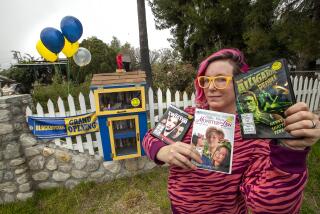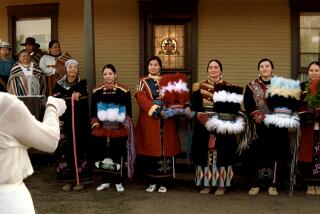Shirley Temple memorabilia evokes memories and the magic of movie stars
On a warm afternoon in early June, when a sane person would have headed for the beach or at least the backyard, I discovered that a collection of Shirley Temple’s toys, dolls, costumes and childhood memorabilia was on display in the Santa Monica History Museum and I went to see it.
I could pretend I went strictly as a journalist and critic, curious as to who and what I would observe, but that wouldn’t be completely true. I went in part because I was a fan — of Shirley Temple, not toys — and that’s what fans do.
But why do fans do things like that, what’s behind the behavior that’s so central to the moviegoing experience? I wanted a chance to think about that, and that show, which turned out to be just the tip of a Shirley Temple iceberg, was a promising place to start.
SIGN UP for the free Indie Focus movies newsletter >>
For those who don’t know, Shirley Temple in her heyday was a cinematic force to be reckoned with. To say she was a child star is to scratch the surface of a quite extraordinary career for which there is no real parallel before or since.
Though Temple made her first short in 1932, it was in 1935 through 1938, between ages 7 and 10, that she broke out. Temple did more than make successful movies, this Tot with Swat was the country’s No. 1 box-office attraction four years running.
In movies like “Little Miss Marker,” “Rebecca of Sunnybrook Farm” and “Wee Willie Winkie” (for crusty director John Ford, of all people), she acted, she sang, she tap-danced with Bill “Bojangles” Robinson. Most of all, she created fans.
Temple’s brassiness, her infectious good spirits and spunky optimism enchanted viewers, creating a cult of personality that began in the Great Depression and has never gone away. No less a dignitary than President Franklin Delano Roosevelt was quoted as saying, “As long as our country has Shirley Temple, we will be all right.” Really.
But when you are a fan, you may want something more than those moments alone in the darkness, you may want some more tangible connection to what you’ve seen on the screen. Which is where that collection of costumes, dolls and toys comes into the picture.
For that showing in Santa Monica and half a dozen other cities like Rochester, N.Y., and Fort Worth, Texas, was not your typical museum exhibition. It was intended in part to drum up interest for a mid-July auction in which nearly 600 items, carefully collected and stored first by the actress’ mother, Gertrude, and then by Temple herself, were going up for sale.
According to Stuart Holbrook, the president of Theriault’s, the auction house that handled the event, Temple (who died in 2014) had hoped for a stand-alone museum for her memorabilia, but it was not to be.
TIMELINE: Kenneth Turan’s 54 favorite films
Factoring in the ongoing costs and responsibilities of preservation and the difficulty of splitting things up among her three children meant that “even before her death she had decided that the children should have her things sold.”
If you wonder who would want some black-and-white-era movie star’s old toys, you just don’t understand the nature of cinematic fandom and the powerful connection major movie stars make with their audience.
Suffice it to say that the 556 Temple items sold for $2.5 million, double the pre-auction estimate. Top price was the $75,000 the Santa Monica History Museum (the actress was born in the city) paid for the red-and-white polka dot dress Temple wore for the “Baby Takes a Bow” number in 1934’s “Stand Up and Cheer” that made her a star.
Other high-ticket items include $45,000 for Temple’s baby grand Steinway piano, $34,000 for a toy racing car she drove with so much abandon it was banned from the Fox lot, $13,000 for a life-size Japanese doll that was bigger than she was, and $4,500 for her student typewriter (bought by L.A. collector Steve Soboroff as a gift for the Smithsonian).
More significant than the money was the massive nature of the response. Holbrook says the number of bidders was “through the roof,” more than 12,000 people, leading to a 13-hour auction, the longest in Theriault’s 40-year history.
“It seems like with every item that was sold there were tears, I never saw a response like that,” Holbrook reported. “I call it ‘One Degree of Shirley,’ everyone had a story to tell about how she impacted their lives. ‘She saved my childhood.’ ‘She was the happiest part of my youth.’ She evoked so many strong emotions in people.”
I did not bid on anything, I wasn’t even seriously tempted, but walking around the Santa Monica exhibition, feeling the serious, respectful attention of the largely female visitors made me speculate on what causes people to reach out to objects in that particular way.
Yes, respect paid to Temple’s talent as well as nostalgia for a past that always seems more blissful and innocent in retrospect, were key factors, but as I wandered from case to case, looking at the costumes from Temple’s famous roles as well as the toys she treasured, something else seemed to be at work as well.
For the physical nature of those items started to feel like tangible and inescapable proof of the reality of this performer whose shadowy image beguiled us in the dark. And if movie stars are real — real enough to have enjoyed objects we can now possess — maybe the positive, even hopeful feelings and emotions they engender in us can be believed as well. And what could be more comforting than that?
In that vein, it’s fascinating to note that Shirley Temple herself was not immune from this dynamic. One of the most interesting items on view was the little star’s series of autograph albums with signatures from everyone from Franklin and Eleanor Roosevelt to D.W. Griffith and Orson Welles, who signed his “from one croquet champ to another.”
Temple, the exhibit informed me, was “continually on the hunt” for autographs from the celebrities who inevitably crossed her path. In the midst of a childhood surrounded by make-believe, maybe those autographs were the connection to the reality of the dream Temple not only wanted but needed. Just like her fans.
MORE:
Big in China? Shirley Temple’s oddly current vogue
Shirley Temple’s mixed legacy for child actors
Remembering Shirley Temple’s magical musical moments
More to Read
Only good movies
Get the Indie Focus newsletter, Mark Olsen's weekly guide to the world of cinema.
You may occasionally receive promotional content from the Los Angeles Times.







